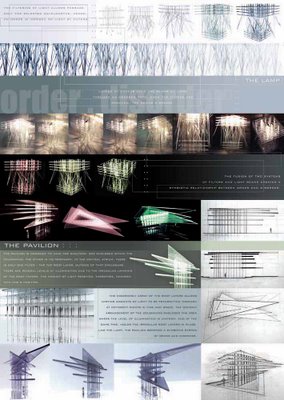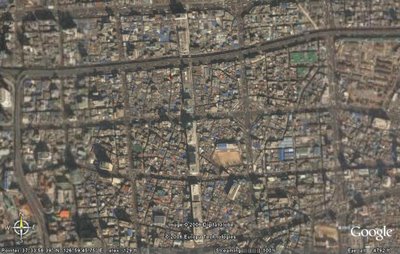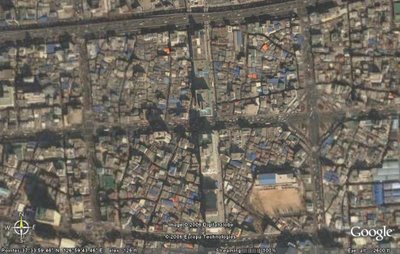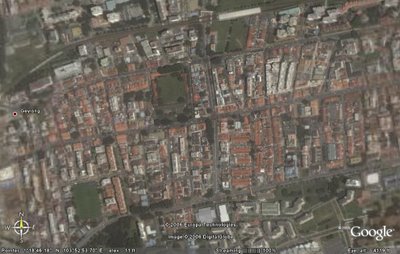Tuesday, October 31, 2006
Monday, October 23, 2006
order/disorder vol. II
Anyway, here's a project I did waaay back in year 1 (therefore very simplistic - don't laugh.) It's to design a lamp, and then design a pavilion from the lamp. (Alan Woo's students would find this familar.)

Well, the idea for the lamp was that layers of (horizontal) filters - polarisers - are that which give the stray (vertical) light rays their order; the removal of which causes them to splay out and be distributed. The pavilion itself was manifested in a change in that order - the (vertical) columns are those which hold the splayed (horizontal) fins together. Thus, there was a supposed intrinsic ordering 'mechanism' that held both the lamp and the pavilion up, such that they are structurally stable and can actually be used as a real lamp and a pavilion respectively.
Hmmm. Sounds simplistic indeed! (Past projects are like ex-girlfriends, you'd love to bring them up from time to time but never really want to talk about them, and both make you go "what was I thinking??")
substrate
http://www.complexification.net/gallery/machines/substrate/index.php

Seems completely random, yet there's a method to the madness. (That 'method' happens to be in Javascript and is hence cryptic to me - anyone know how to program / read something like that?)
Well, if ever you need to generate a city in minutes, this might be a start!
Sunday, October 22, 2006
The new aesthetic?
 source: Archinect
source: Archinect Doesn't this new skyscraper in Dubai by RUR Architecture look vaguely familiar....?
Tuesday, October 10, 2006
disjunctive thoughts
Anyone dealing with digital media / photography tomorrow? Need me to bring in an inkjet printer and paper?
If so, would be grateful if users could pay $1 or $2 per pax for usage, depending on generosity and amount printed. =P I don't have a ready laptop with me either so any volunteers to bring one?
Drop in a comment if:
1. you want an inkjet printer to be brought in
2. you can bring a laptop
Cheers!
hann
Friday, October 06, 2006
Framing Order in Disorder

Cheonggyecheon, Seoul, S. Korea
As I think of the example of using framing to impose an order upon something in disorder, I'm reminded of this aerial photo of Cheonggyecheon, Seoul, S. Korea. The orthogonal roads have framed each parcel of land, where within the parcel exists many little houses, businesses packed in a tightly-knit organic fashion. Such a phenomenon is not uncommon in old cities. Is this then the example in framing of disorder, viewed from the aerial perspective of the city? Certainly, this is not the only way of understanding or experiencing our city. Are there other ways or perspectives of viewing our city which reveal order in disorder?
 Cheonggyecheon, Seoul, S. Korea - closer view
Cheonggyecheon, Seoul, S. Korea - closer view
 Geylang, Singapore
Geylang, Singapore
In contrast, the aerial photo of Geylang, Singapore, reveals strict ordering principles throughout the parcels of land.
 Geylang, Singapore - closer view
Geylang, Singapore - closer view
(Aerial photos obtained through Google Earth.)
Thursday, October 05, 2006
Chaos theory parallels
In particular, some interesting points to take note of are:
One defining characteristic of chaotic systems is that they are sensitive to initial conditions. Again there are a number of levels for viewing this. Mutational effects on basic DNA conditions are the fundamental reason for the diversity we see in nature. A new leaf that falls on the forest floor has multiple consequences on the system (it covers other items under it, provides a refuge for new growth etc), instigating a change in the micro-ecology of that area that may result in a macro-effect on the entire forest. This is likened to the "butterfly effect".
When we link chaos theory to organisational development, say in the evolution of entities like Wikipedia, Google or other open source bottom-up systems, we think about an "organization where system changes are made by recalculating, re-inventing and modifying its structure in order to adapt, survive, grow, and develop." Imagine organisations "that allows self-organization, rather than attempting to control the bifurcation (the splitting point of changes) through planned change." (Dooley, 1995)", which is in contrast to top-down approaches which create planning authorities and attempt to control every aspect of an inherently chaotic system. The result is likely to succeed in the short term, but fail in the long.
A crucial line from the Wikipedia article worth digesting is this: "While maintaining an equilibrial state seems to be an intuitively rational method for enabling an organization to gain a sense of consistency and solidarity, existing on the edge of a chaotic state remains the most beneficial environment for systems to flourish develop and grow."
To do so requires the careful injection of timed interventions (read: on the part of the architect) that do not dictate directions but shape them in a constant flux. The key lies in a "developing system that changes shape but retains the same familiar face." Think about how Google's company philosophy works and we start to see how such systems function. The 'core values' (for want of a better term) become very important. The approach, attitudes and principles, crucial. We can also once again link back to the idea of a leaf with an undefinable 'familiar face'.
Disorderly order
First of all, how do we define “disorderly”?
Do we define it as “something that is not orderly”?
If we do, does “orderly” refer to industrial aesthetic?
Secondly, why do we seek “disorderliness” ?
Is it because it contrasts with the “orderliness” of industrial aesthetic, which we are trying to get out of?
Or is it because we suspect that it is a necessary resultant aesthetic when we design based on biological sensibilities?
Thirdly, what is the significance of Kheng Soon’s example of taking a photograph of a forest floor with regards to “disorderly order”?
Is it an example of how one can impose an order upon something “disorderly” through framing?
Or is it an example of how one can uncover and express understanding of an inherent order of something “disorderly” through framing?
